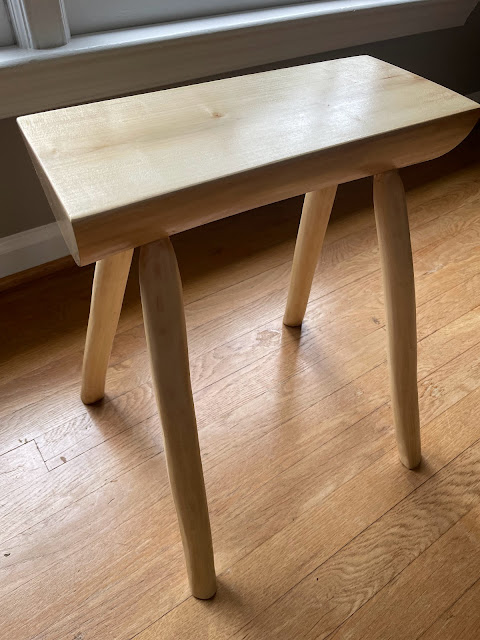 |
| Mission style bench in walnut |
I seem to be in a bench-building phase. There are a variety of styles that encourage different techniques in joining, layout, cutting and finishing. That probably explains why I always feel like a complete beginner making the next one.
I'm following Rex Krueger's plans (https://tinyurl.com/3tkut342), but rather loosely. The first change: Susan suggested using a "darker wood" this time. So I got in touch with Dick Ratcliff at http://www.heartwoodcreations.org/ again. He found a nice walnut live-edged slab and was kind enough to plane it to the thickness I wanted. As I mentioned in my Moravian stool post, Dick is a great guy to deal with when you need wood.
I also decided not to use nailed construction. Rex does a good job explaining it, and I know it's a real technique with a long history, but it just wasn't the look I wanted. I'm always trying to use contrasting woods, and here I'm using birch dowels in place of the cut nails. It was a lot more effort than I anticipated. A particular challenge was holding the various parts in alignment before drilling the dowel holes. It took more time to rig that up than it took to drill the holes, and then I discovered a couple weren't aligned anyway. So even more time spent making a patch.
.jpg) |
| Keeping parts aligned for dowel drilling |
.jpg) |
| Finished dowel joint |
Now, about that live edge: keep it or cut it off, leaving just the heartwood? I kept part of the sapwood on the legs (they are tapered, rather than rectangular) and all of it on the top. So the bench top has one side that is not straight...my first foray into a live edge project.
The legs need to be identical, so I used Rex's technique of double-sided tape to hold the blanks together while I cut the tapers with a circular saw. Then I separated them and used a jigsaw to cut the ogee curves that form the feet. I was happy to see how smoothly that went, after watching jigsaw tips from the Honest Carpenter (https://www.youtube.com/watch?v=Fsdsp3cxLlc). I wasn't as lucky when notching the legs to hold the aprons. I used my Japanese style pull saw and one cut got far off track. Another patch was needed there. Things like that are why I call my work "rustic".
The plans call for nailing the bench top to the base. Eschewing nails, I thought maybe I'd use dowels on the top too. But the top is the prettiest piece of the walnut. Instead I used Z clips to fasten the top on. Another new technique. Let's see if they hold up to wood movement as they are supposed to.
The finish is Waterlox Original. I hadn't used it before, and I'm happy with the warm semigloss result.





.jpg)
.jpg)















